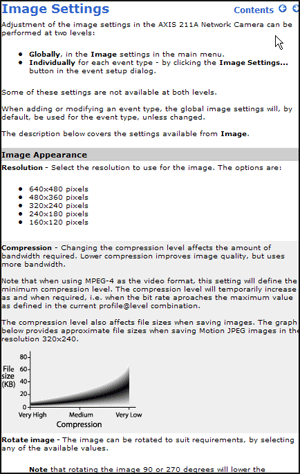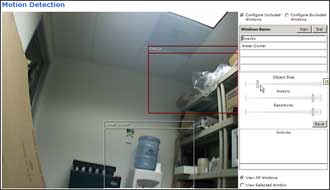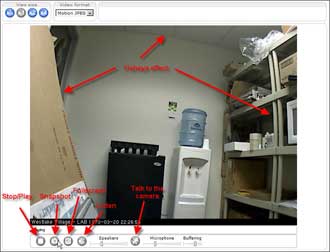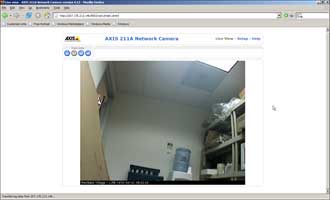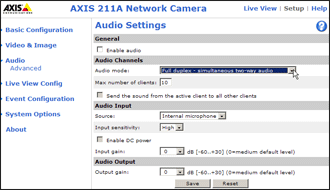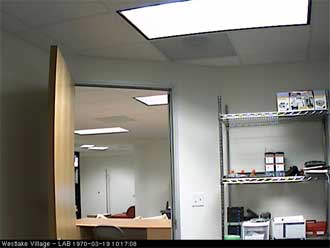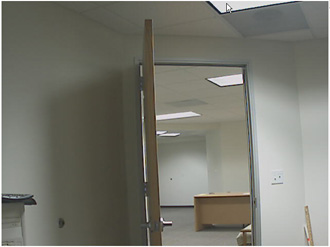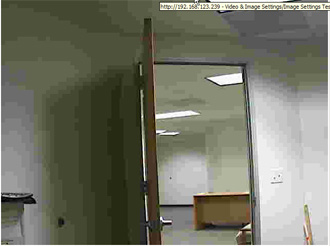Introduction
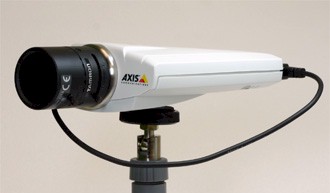
| Axis Network Camera | |
|---|---|
| Summary | Pro-level network camera with superior image quality, two-way audio & 802.3af PoE |
| Update | None |
| Pros | • Excellent picture quality • Clear audio from the camera • Flexible alert setup • 802.3af PoE |
| Cons | •Audio functions only work in Internet Explorer •Audio to the camera is a little choppy •Cannot record audio •No HTTPS access |
Network cameras have long been able to stream pictures and video across the globe, but audio monitoring is fairly new. A few months ago, we reviewed the Actiontec Wireless Network Camera, which had audio listening and recording capabilities, but marginally acceptable image quality.
Now, Axis Communications – a monster in the video surveillance market – has released its Axis 211A Network Camera, which combines high quality audio monitoring with top-notch video quality. Let’s see what it has to offer.
Basic Features
The 211A comes with a full complement of ports as shown in Figure 1. From left to right, you can see connectors for the:
- DC-Iris control cable
- External Microphone/Line Input
- Audio Output
- Ethernet Connector
- Power Connector
- I/O terminal connector
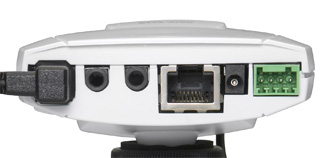
Figure 1: Axis 211A rear with ports
The microphone input and audio output ports accept 3.5mm plugs. You probably won’t need to use the microphone jack, as the built-in microphone on the bottom of the camera provides decent sound. Powered speakers must be connected to the audio output jack if you want to take advantage of the two-way audio feature.
The I/O terminal block has connections for alarm input, output and “alternative power supply”, but I did not test this feature in our review. Note that all ports are labeled on the underside of the unit (Figure 2).
Figure 2: The ports are labeled on the underside of the camera
(click image to enlarge)
In addition to the camera, Axis includes a stand that screws into the 211A’s standard tripod mount, 100-240V power supply, installation CD, and printed User Manual. Note that the 211A also supports IEEE 802.3af Power over Ethernet (PoE) so that you don’t have to worry about locating the camera near an AC outlet.
More Basic Features & Specifications
Tamron, a large player in the film and digital camera market, makes the lens for the 211A. The focus and zoom are manually adjusted by loosening the small thumbscrews and then twisting the lens. This particular Axis camera does not automatically pan and tilt, nor does the lens automatically zoom and focus. While this may seem to be a negative, bear in mind that this network camera is meant to be placed in a fixed location, covering a single spot.

Figure 3: Tamron Lens Focus (Top) and Zoom Controls (Bottom)
The lens and CCD have a light sensitivity from .75 to 500,000 lux, which is a far greater range than provided by less expensive network cameras. The CCD is a 1/4 inch Sony Wfine progressive scan CCD, which produces excellent quality video and still images, which I’ll demonstrate shortly. Note that by default, the iris automatically adjusts to lighting changes, but you can disable this if you prefer.
Other video specs are found in Table 1 below.
| Image Sensor | 1/4 inch Sony Wfine progressive scan RGB CCD |
| Lens | Tamron varifocal 3.0 – 8.0 mm F1.0 Focus.2 meters to Infinity |
| Light Sensitivity | .75 to 500,000 lux |
| Video Compression | Motion JPEG and MPEG-4 |
| Resolution | 640 x 480 to 160 x 120 |
| Frame Rate | Up to 30 frames per second in all resolutions |
| Video Streaming | Simultaneous Motion JPEG and MPEG-4 |
| Image Settings | 11 Compression Levels for Motion JPEG, 23 Compression Levels for MPEG-4 |
| Shutter Time | 2 Seconds to 1/12500 Seconds |
| Table 1: Axis 211A Video Specifications | |
Installation and Configuration
The 211A runs an embedded web server and in order to access this server, you must assign an IP address to the network camera. There are six ways to do this:
- Axis IP Utility
- UPnP
- ARP/Ping
- Axis Dynamic DNS Service
- DHCP
- Static IP
Axis recommends using its IP Utility to configure the IP address of the 211A. This is done by connecting the Axis 211A to your network and popping the installation CD into any computer running Windows 2000 / XP. The IP Utility will automatically run and find all the Axis cameras on your network.
Figure 4: IP Utility automatically finds all Axis cameras on the network
Right-clicking on a camera (Figure 4) will allow you to set its IP address and view its built-in Home Page. You can verify that you are configuring the correct camera by matching up the serial number reported by the utility (Figure 5) with the number on the underside of the camera.
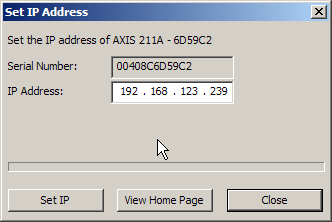
Figure 5: Setting the IP Address
Figure 6: Success!
Users of operating systems other than Windows will have to use the other four methods of setting the IP address. Note that DHCP is enabled by default and the camera will default to 192.168.0.90 if it doesn’t find a DHCP server.
Axis Dynamic DNS Service
If you’re going to make the 211A accessible from the Internet, you’ll probably be interested in Axis’ Internet Dynamic DNS Service. This is a FREE service that allows you to assign a fixed domain-based address to your Axis network camera that can track the changing IP addresses used by most ISPs.
You configure the service by connecting the 211A to your network, and pressing the control button on the underside of the camera once. The Status Indicator will turn green while it connects to the Internet and talks to the Axis Internet Dynamic DNS Service. You then surf to the Axiscam.net webpage and type in the serial number on the underside of the camera to complete registration.
Tip: This service will not work if your Internet connection runs through an HTTP Proxy. You’ll also need to open the port used by the camera (default is 80) on your router’s firewall.
Setup and Administration
After setting up the IP address, you access the configuration page by typing the assigned IP address into your web browser. The configuration pages (Figure 7) let you set options such as Audio/Video quality, alert types and network settings.
Figure 7: Basic Configuration Page
(click image to enlarge)
Security features are decent, although I would have liked to have seen support for HTTPS connections. I liked that the setup forces the user to set a password for the root user upon first login, and that you can change the default port of the 211A’s webserver from its default of 80, which can help fend off quick port scans. I was also pleased to see that while anonymous viewing (which allows viewing live video without needing to provide a username and password) is supported, it is turned off by default.
Multiple users can be created, and assigned Viewer, Operator or Administrator privileges. (Viewers are view-only, Administrators are fully privileged and Operators are somewhere in between.) Note that the root user, who has full privs cannot be renamed or deleted. While the 211A does not support secured HTTPS connections, there is an Allowed IP Address list (256 entries max.). There is also a Referrals feature to prevent unauthorized clients from including the 211’s video stream into external Web pages.
Tip: If you make your camera accessible from the Internet want to keep access to its output private, you’d better set a strong password. Because Google provides a handy way for snoopers to find and view unprotected cameras.
Configuring the 211A is easy, as the menus are logically laid out. Every page has a Help feature that can be accessed by clicking the question mark on the upper right corner. As you can see from Figure 8, the help screens explain every setting in great detail. You can also view a live video feed by clicking Live View in the upper right corner of any admin page.
Figure 8: Easy to understand help menus
(click image to enlarge)
Alerts, Motion Detection, Live Video
Customized alerts and motion detection areas can easily be configured. Multiple motion detection zones can be drawn on a live preview screen, and you can give each zone a name and different motion detection tolerances. An activity window in the bottom right corner also shows a real-time graph of activity. (In Figure 9, the graph is blank because the camera cleared the screen before I could run back to the laptop and do a screen capture.)
Figure 9: Setting up motion detection areas
(click image to enlarge)
Different email alerts can be sent for different detection zone triggers. In the example scene above, if someone steps in front of the water cooler, an alert will be sent to one email address. But if someone steals snacks from the top shelf, a different email message is sent to a different email address. The email subject line and content can be customized in almost infinite ways.
Email alerts can be sent 24/7 or can be tailored to ignore certain time periods. For example, you may want to ignore motion during business hours, and then turn on detection after 6PM and all day on weekends. In addition to sending alerts, “snapshots” can be saved on either FTP or HTTP servers.
Figure 10: Axis 211A Live Webpage View – Lens on widest setting
(click image to enlarge)
As I covered earlier, the live video feed from the camera can be easily accessed. But taking advantage of the 211A’s audio features or taking frame-grab “snapshots” requires using Internet Explorer since the features use ActiveX controls.
Figure 11 is a Firefox screenshot, where you can see that the toolbar visible in the bottom of Figure 10 is missing.
Figure 11: Non-IE browsers have some features disabled
(click image to enlarge)
Note that in contrast with some of its less expensive competitors, the 211A does not include a way to capture video.
Audio Features
Using the audio features of the 211A will require attaching powered speakers to its audio out jack (Figure 12) and a microphone and speakers (or PC headset) on the computer accessing its web interface. And, as I’ve mentioned above, you’ll need to be using Internet Explorer as a web browser.
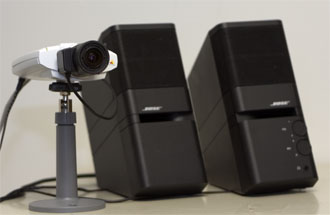
Figure 12: Axis 211A connected to two Bose powered speakers
The 211A supports two audio channels between it and web-based clients – one for receiving and one for transmitting audio – using either the G.711 PCM codec @ 64 kbits/sec or G.726 ADPCM codec @ 32 or 24 kbits/sec. Each audio channel can be turned on or off, which means that there are four audio mode options (plus audio disable):
Full-duplex mode
This mode is similar to using a telephone – you and the remote party can talk and listen at the same time, without having to use the “push to talk” controls
Half-duplex mode
Transmits and receives audio in both directions, but in only one direction at a time. This means that you select when to receive or transmit audio by using the microphone icon on the ActiveX toolbar
Simplex – speaker only mode
The powered speaker connected to the 211A will play audio, but no audio will be transmitted from the AXIS 211A to other web clients
Simplex – microphone only mode
Transmits audio from the 211A to web clients, but will not receive audio from web clients
Figure 13: Configuring the audio settings
(click image to enlarge)
The 211A also has advanced audio controls including a speech filter and noise and echo cancellation.
Axis claims that up to 10 people can simultaneously listen to an audio stream when the camera is in full-duplex mode. I didn’t test that limit, but was able to test up to three simultaneous listeners with no loss in audio quality – which was excellent.
In contrast to the excellent received audio quality, I judged “talk” quality to be only acceptable, with a fair amount of static audible in the background. As with video, Axis doesn’t bundle a way to record audio to or from the camera. So you’ll need to either purchase Axis’ pro-level (and priced to match) AXIS Camera Recorder software, or use third-party software.
While being able to talk to an intruder may seem like a novelty at first, it can help prevent crime. Traditionally, cameras have passively recorded thefts, which helps in prosecution after a crime has been committed. This is great, but you have to endure the hassle of filing a police report and waiting for your stuff to be returned. Why not instead stop intruders in their tracks by directly letting them know with your own voice that they are being watched?
Video Quality
On the lower compression settings, I thought the video quality was excellent. I streamed video to viewers both on the Internet and on my local area network and had no problems viewing 30 frames per second (fps) at 640 X 480 on the local network. But while sitting at Starbucks and using a TMobile Wi-Fi connection, the frame rate appeared to be around 20 fps.
As I mentioned earlier, the 211A’s built-in software lets you record only still frames, but you can set the camera to upload a JPG stream to a server and then manually process the JPGs to make a movie. A much easier way to go, however is to purchase a third-party program that can make a movie on the fly.
Figures 14 through 17 demonstrate picture quality at different compression settings (all the pictures can be enlarged to full-size by clicking on them). You can see that the quality remains very good up to 50% compression, but drops dramatically at higher compressions. I judge the results to be unacceptable at 80% to 100% compression.
Figure 14: Test Capture at 10% compression with Text Overlay
(click image to enlarge)
Figure 15: Test Capture at 25% Compression
(click image to enlarge)
Figure 16: Test Capture at 50% Compression
(click image to enlarge)
Figure 17: Test Capture at 100% Compression
(click image to enlarge)
You may want to compare the quality against desktop webcams tested in this previous article, or the Actiontec Network Camera.
Closing Thoughts
The Axis 211A obviously commands a premium price, but what do you get versus lower-priced network cameras such as the Actiontec 54 Mbps Wireless Network Camera? The main place where your money goes is into buying superior image quality due to the Axis’ high-quality CCD image sensor and superior Tamron lens. Other primary differentiators are the 211A’s full-duplex audio capability and 802.3af PoE.
For the premium price, you might wonder why Axis doesn’t bundle a recording application with the 211A. But when you consider that one of Axis’ primary markets is professional video surveillance, you might understand the mindset that treats recording as a separate (charge for) product. You also don’t get wireless capability for your bigger bundle of cash, but that’s not as big a negative as you might think.
I’d argue that while the Actiontec can transmit its data “wirelessly”, its dependence on an AC outlet to power its wall-wart could result in more restrictions on locating it. With the 211A’s built-in POE, all that’s needed is a single CAT5 Ethernet cable to provide both data and power. Yes, you can buy kits to jury-rig PoE for the Actiontec, but it’s an added expense and the result isn’t very elegant.
The bottom line is that the Axis 211A is a professional-grade surveillance camera capable of producing excellent image quality over a wide range of lighting conditions with integrated full-duplex audio capability. While not every network camera application requires such performance, if yours does, the Axis 211A can deliver.





